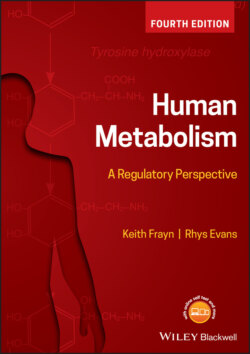Читать книгу Human Metabolism - Keith N. Frayn - Страница 35
1.3.2.1.2 Glycolysis
ОглавлениеGlucose (6 carbons: molecular formula C6H12O6) is broken down by the pathway of glycolysis to pyruvate (3 carbons: C3H4O3, showing that H has been lost relative to C and O; i.e. overall this is a partial oxidation); the term glycolysis refers to this splitting of the glucose molecule. A small amount of ATP is generated by substrate-level phosphorylation in glycolysis, hence some usable energy is generated. Indeed, this is a cytosolic pathway and occurs even in cells that lack mitochondria, such as red blood cells (it is their only route for making ATP). Glycolysis ends at pyruvate. This important intermediate can be subsequently: 1, reduced to lactate (C3H6O3, so exactly half a glucose molecule with no redox changes – a true fermentation reaction); 2, oxidised (and decarboxylated) to form acetyl-CoA; 3, carboxylated to form oxaloacetate (anaplerosis); or 4, transaminated to form the amino acid alanine (see Section 1.3.4 below).
Glycolysis is a primitive but vital pathway that occurs in the cytosol of all cells and comprises an initial energy investment phase (priming – phosphorylation) followed by splitting (6 carbons into 2 × 3 carbons), and an energy generation phase of oxido-reduction and phosphorylation. During this phase NAD+ is reduced to NADH and ATP is produced by substrate-level phosphorylation. Glycolysis of one molecule of glucose therefore yields two molecules of pyruvate, 2 ATP and 2 NADH without requiring oxygen. Glycolysis is a vital pathway because of its multiple functions. In muscle, glycolysis splits glucose in order to provide energy, but in liver, excess glucose remaining once glycogen stores have been repleted is broken down by glycolysis to pyruvate, then acetyl-CoA, for lipid synthesis.
